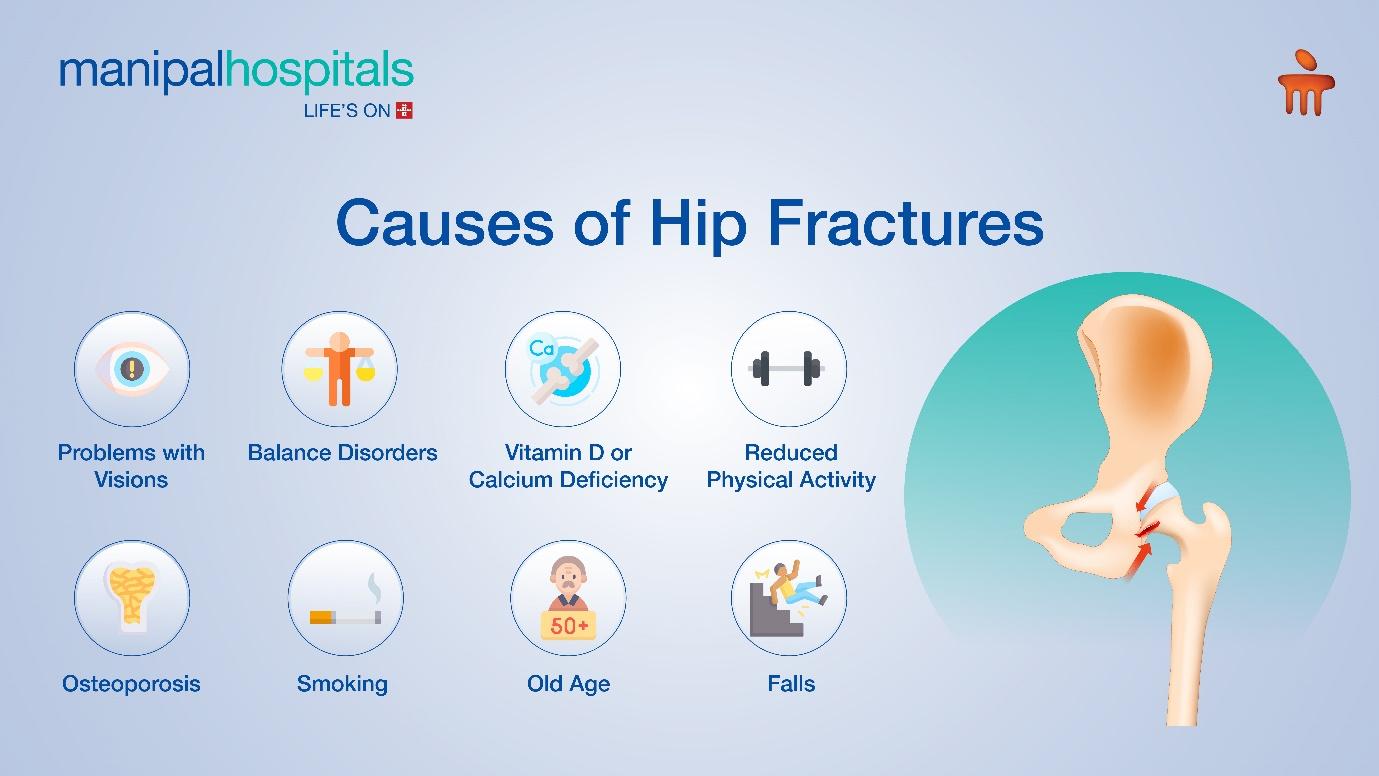
Almost all kinds of fractures make it tough for a person as they affect a person's ability to move and curtail their independence. However, hip bone fractures pose a higher level of danger because they not only affect overall mobility, keeping the person bedridden, but also create grave threats of blood clots and other complications.
Synopsis
What is Hip Bone Fracture?
A hip bone fracture, or a hip fracture, occurs when the upper part of the thigh bone breaks, particularly the area that forms the ball and socket joint with the hip bone. Due to their high risk of mortality and associated complications, hip fractures are the most common emergency cases. Hence, hip fracture surgery is the only route of treatment
What Causes Hip Fractures?

Old age and falls are primary causes of hip fractures and these fractures are more common in women. However other factors that can put a person at risk for hip fractures include:
-
Being underweight
-
Insufficient levels of vitamin D or calcium
-
Family history of osteoporosis
-
Not enough physical activity
-
Smoking
-
Vision problems make one more prone to falls
-
Neuromuscular disorders where there are issues with balance (Parkinson’s disease, dystonia, stroke, peripheral neuropathy)
-
Fainting episodes
What are the Symptoms of a Hip Fracture?
A hip fracture can greatly affect a person’s ability to move. Hence, immediately identifying the symptoms can help with prompt treatment. Some of the signs are:
-
Unable to get up from a fall
-
Swelling and bruising around the hip area
-
Inability to walk
-
The leg is shorter on the side of the injured hip.
-
Outward turning of the leg at the injured hip.
Consult our orthopaedic hospital in Mangalore if you are experiencing the above hip bone fracture symptoms.
Where Does a Hip Fracture Happen?
Hip fractures typically occur when the upper part of the thigh bone breaks. However, the specific location of the break on the thigh bone determines the course of treatment. Hip fractures happen in two main locations:
-
The femoral neck: The upper portion of the thigh bone has a ball-like protrusion that forms the head and neck of the bone. This neck fits into a cavity (acetabulum) found in the hip bone, creating the ball and socket joint. When there is a fracture in the femoral neck, it is dangerous as it can affect the blood supply to that region.
-
The intertrochanteric region: is found farther down from the ball and socket jo It is the part of the femur that juts outward. Fractures in this area are less severe as there are no major surrounding blood vessels.
What Happens if a Hip Fracture is Not Treated?
Delays in treating and repairing a hip fracture carry severe complications. It damages the surrounding muscles, ligaments, blood vessels and nerves and can also lead to:
-
Blood clots in the legs and lungs
-
Bed sores
-
UTIs
-
Pneumonia
-
Loss of muscle mass which can lead to more falls
Consult our orthopaedic surgeon in Mangalore if you need hip fractures treatment.
What is the Treatment for Hip Fractures?
After physically examining the patient, the doctor will conduct an X-ray to confirm and understand the location of the fracture. If the fracture is a hairline crack and not visible on an X-ray, but the patient still feels pain, an MRI or a bone scan will help analyse the fracture.
Treating a hip fracture promptly is crucial, which involves surgical intervention along with rehabilitation, physical therapy, and medication to manage blood clots. Based on the fracture's location and severity, and considering the patient’s age, the doctors will determine the type of surgery needed. The surgery types include:
-
Surgeons insert metal screws into the bone to hold it in place while the fracture heals. They also attach these screws to a metal plate that runs down the thigh bone.
-
In total hip replacement, surgeons completely replace the upper femur and socket with prosthetic counterparts. Increasingly, studies show that total hip replacement is more cost-effective and associated with better long-term outcomes
-
Surgeons may also opt for a partial hip replacement, replacing only the ball part of the hip with a prosthetic. They suggest this approach if the blood supply to the area is interrupted or if the patient is older, and the femur may not be in a position to heal.
While surgery can repair the hip fracture, gaining the ability to move and become independent is essential for improving the patient’s quality of life. This is where rehabilitation, physical therapy and occupational therapy come in handy all of which aim to improve movement, and range of motion and boost the patient’s confidence.
If you or your loved ones suffer a fall and experience the symptoms of hip fracture, please do visit the experts at the Orthopaedics Department at KMC Hospital, Mangalore. The orthopaedics doctors will thoroughly understand a hip fracture and provide surgical advice and guidance.
FAQ's
The primary causes are falls (especially in older adults with osteoporosis), high-impact injuries or trauma (like a car accident), and conditions that weaken the bones like osteoporosis, cancer, or stress injuries.
Blood clots, infection at the surgical site, injury to blood vessels or nerves, implant failure or dislocation, inability to regain full mobility, and death (in very frail elderly patients).
It requires an inpatient hospital stay initially. Physical therapy is essential to regain mobility, strength and range of motion. Full recovery can take 3-12 months. Assistive devices like walkers or canes are usually needed.



















 5 Min Read
5 Min Read

















